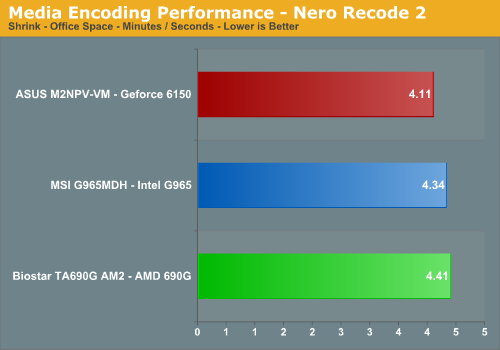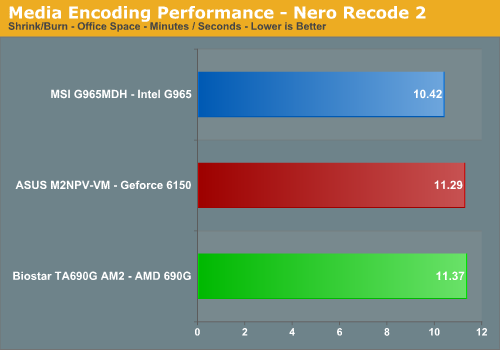Media Encoding Performance
A traditional weak spot of the current AM2 processor offerings has been in the media encoding arena when compared to the Intel Core 2 Duo. Considering the main optimizations for the Core 2 Duo centered on overall media encoding performance, we were very interested in seeing how this platform compared to current AMD lineups. We are utilizing an updated video encoding test suite for this article that includes AnyDVD, Nero Recode 2, Windows Media Encoder 9, and QuickTime Pro 7.1.
Our first series of tests is quite easy - we take our original Office Space DVD and use AnyDVD and Nero Recode 2 to copy the full DVD to the hard drive without compression, thus providing an almost exact duplicate of the DVD. We then fired up Nero Recode 2, selected our Office Space copy on the hard drive, and performed a shrink operation to allow the entire movie along with extras to fit on a single 4.5GB DVD disc. We then go back and use Nero Recode to shrink the full DVD copy and burn it onto our DVD disc. We left all options on their defaults except we checked off the advanced analysis option. The scores reported include the full encoding process and are represented in minutes/seconds, with lower numbers indicating better performance.



The results are very interesting as we did not expect our AM2 systems to perform this well and to do so is very surprising when reviewing other media encoding results. In fact, we ran the test several times and verified our settings before accepting the test results. Perhaps the last few months of Core 2 Duo results constantly exceeding AM2's best by a wide margin have tainted our cognitive abilities.
Of course, we are using a mid-range AM2 processor against the budget C2D part (the AMD price cuts have helped matters there, as the price difference is currently only about $35) but we fully believe the majority of the performance difference lies in the chipset selection on the AM2 systems. It is only in the shrink and burn tests that we see the Intel platform flexing its muscles. The difference in the shrink portion of this test was minimal and mirrored our individual shrink test results. We noticed our Intel platform was able to feed data to our DVD drive in a consistent manner with each of the AM2 platforms suffering from stutters several times resulting in our drive slowing down during the burn process. It was difficult to figure out if this was a driver, disk controller, or CPU issue. We are still testing on other chipset and CPU combinations.
Our next test has us converting our day at the beach AVI file into a high definition WMV file suitable for our Aunt Gertrude to view on her new high definition LCD TV. We ensured our quality settings were set for High Definition output. The remaining options are left at default values and then we let this program do its magic. We are reporting the numbers in minutes/seconds to complete the conversion.

These results left our heads shaking and we busily scurried off to the far corners of the lab looking for answers. After several test repeats, a few new images, and a couple of drinks, we stand by the results. Our answer, which we came up with after we switched out the MSI G965 board for a Gigabyte G965 board and had the same results, is that our E6300 is just incapable of keeping up with our AM2 5200+ X2 in this test. Why? It's all about the cache and CPU speed. Our E6600 trounces the 5200+ X2 at stock speeds and scores near it when running at E6300 speeds thanks to the increased cache. Meanwhile, our E6400 is just slightly off the 5200+ X2 pace at a modest 300MHz increase in speed over the E6300.
Next on the list is our QuickTime Pro 7.1 test that will convert our newly downloaded .Mov file into a plasma screen pleasing H.264 format. We ensured our quality settings were set to their highest levels and then let the horses loose. The values reported are again in minutes/seconds for the conversion time, with lower numbers being better.

Once again, the AM2 platforms have a slight advantage with the 6150 scoring outside of the norm in this test - so far outside that we thought something was not kosher in the land of NVIDIA. Fortunately for us, the answer was easy once we reviewed the playback files. It seems as though the quality of our encoding results on the NVIDIA platform left much to be desired along with numerous frames missing during playback or other frames just tangled together at times. We ran this same test under XP without an issue so our first blip with Vista has now occurred. Our video images are presented below.
In these particular screen shots both the G965 and 690G image quality results are basically even, but the 6150 is showing a case of the jaggies at full screen resolution. The entire playback file suffered from this issue.
A traditional weak spot of the current AM2 processor offerings has been in the media encoding arena when compared to the Intel Core 2 Duo. Considering the main optimizations for the Core 2 Duo centered on overall media encoding performance, we were very interested in seeing how this platform compared to current AMD lineups. We are utilizing an updated video encoding test suite for this article that includes AnyDVD, Nero Recode 2, Windows Media Encoder 9, and QuickTime Pro 7.1.
Our first series of tests is quite easy - we take our original Office Space DVD and use AnyDVD and Nero Recode 2 to copy the full DVD to the hard drive without compression, thus providing an almost exact duplicate of the DVD. We then fired up Nero Recode 2, selected our Office Space copy on the hard drive, and performed a shrink operation to allow the entire movie along with extras to fit on a single 4.5GB DVD disc. We then go back and use Nero Recode to shrink the full DVD copy and burn it onto our DVD disc. We left all options on their defaults except we checked off the advanced analysis option. The scores reported include the full encoding process and are represented in minutes/seconds, with lower numbers indicating better performance.



The results are very interesting as we did not expect our AM2 systems to perform this well and to do so is very surprising when reviewing other media encoding results. In fact, we ran the test several times and verified our settings before accepting the test results. Perhaps the last few months of Core 2 Duo results constantly exceeding AM2's best by a wide margin have tainted our cognitive abilities.
Of course, we are using a mid-range AM2 processor against the budget C2D part (the AMD price cuts have helped matters there, as the price difference is currently only about $35) but we fully believe the majority of the performance difference lies in the chipset selection on the AM2 systems. It is only in the shrink and burn tests that we see the Intel platform flexing its muscles. The difference in the shrink portion of this test was minimal and mirrored our individual shrink test results. We noticed our Intel platform was able to feed data to our DVD drive in a consistent manner with each of the AM2 platforms suffering from stutters several times resulting in our drive slowing down during the burn process. It was difficult to figure out if this was a driver, disk controller, or CPU issue. We are still testing on other chipset and CPU combinations.
Our next test has us converting our day at the beach AVI file into a high definition WMV file suitable for our Aunt Gertrude to view on her new high definition LCD TV. We ensured our quality settings were set for High Definition output. The remaining options are left at default values and then we let this program do its magic. We are reporting the numbers in minutes/seconds to complete the conversion.

These results left our heads shaking and we busily scurried off to the far corners of the lab looking for answers. After several test repeats, a few new images, and a couple of drinks, we stand by the results. Our answer, which we came up with after we switched out the MSI G965 board for a Gigabyte G965 board and had the same results, is that our E6300 is just incapable of keeping up with our AM2 5200+ X2 in this test. Why? It's all about the cache and CPU speed. Our E6600 trounces the 5200+ X2 at stock speeds and scores near it when running at E6300 speeds thanks to the increased cache. Meanwhile, our E6400 is just slightly off the 5200+ X2 pace at a modest 300MHz increase in speed over the E6300.
Next on the list is our QuickTime Pro 7.1 test that will convert our newly downloaded .Mov file into a plasma screen pleasing H.264 format. We ensured our quality settings were set to their highest levels and then let the horses loose. The values reported are again in minutes/seconds for the conversion time, with lower numbers being better.

Once again, the AM2 platforms have a slight advantage with the 6150 scoring outside of the norm in this test - so far outside that we thought something was not kosher in the land of NVIDIA. Fortunately for us, the answer was easy once we reviewed the playback files. It seems as though the quality of our encoding results on the NVIDIA platform left much to be desired along with numerous frames missing during playback or other frames just tangled together at times. We ran this same test under XP without an issue so our first blip with Vista has now occurred. Our video images are presented below.
 690G - Click to enlarge |
 G965 - Click to enlarge |
 6150 - Click to enlarge |
In these particular screen shots both the G965 and 690G image quality results are basically even, but the 6150 is showing a case of the jaggies at full screen resolution. The entire playback file suffered from this issue.










70 Comments
View All Comments
chucky2 - Wednesday, March 7, 2007 - link
BlingBlingArsch of the AnandTech forums linked to some pictures of the board, and there's one of the back panel I/O: http://img256.imageshack.us/img256/5498/board234cx...">http://img256.imageshack.us/img256/5498/board234cx...Looks like there's definitely no Firewire... :( :( :(
What are these manufacturers thinking (or rather not thinking) not including Firewire on this boards? These would be totally complete solutions, especially this Abit with the optical out it has, if they'd only have Firewire on them...
...and the expansion is so limited, putting in an add-in Firewire basically kills for TV tuner, capture, etc. additions.
Man...talk about something that's almost perfect that gets ruined by either a poor design decision or a poor bean counter decision... :(
Chuck
Myrandex - Wednesday, March 7, 2007 - link
"The 6150 performs okay considering the age of its core and we will see the new 6150SE and older 6100 chipset performing a few percent better overall but not enough to catch the 690G."How would the 6100 be a few percent better when it is clocked lower?
Renoir - Tuesday, March 6, 2007 - link
The review over at http://www.bit-tech.net/hardware/2007/03/02/amd_69...">Bit-tech.netsays the 690G supports dual-link DVI and confirmed as much by sending 2560x1600 over DVI to the dell 30incher. This review however says "Larger 30" flat panel monitors won't be able to run at native resolution" and the technology overview article says "The digital outputs use TMDS transmitters that run at 165MHz". What's the deal?Gary Key - Wednesday, March 7, 2007 - link
The 690G supports Dual-Link DVI. We had stated this on page two but not in a separate section. I will reword the 2D paragraph to make this clear. As for the resolution, I am using a Samsung 30" panel and the current Vista drivers limit me to 2048x1536. I have sent a board to Jarred who has the Dell 30" to test on it. AMD still confirms that 2048x1536 is the "current" max resolution although we know the hardware has 2560x1600 capability according to one of our sources.Renoir - Wednesday, March 7, 2007 - link
Hmmm something's not quite right it seems. Can't see why they were able to send 2560x1600 if you couldn't. Would definitely appreciate Jarred checking it on the dell although I'd be surprised if it was a monitor issue. Who knows without trying. Have asked bit-tech what os they were using to get it to work. An XP vs Vista issue perhaps? The related paragraph in the technology overview article mentions the TMDS's run at 165mhz which I understand is single-link? Have seen the 165mhz listed elsewhere for the 690G so am curious where this info comes from if the chipset is dual-link? Unless I've misunderstood something about "165mhz"?Gary Key - Wednesday, March 7, 2007 - link
The DVI spec transmits data using the transition minimized differential signaling (TMDS) protocol. The DVI spec calls for each DVI output to have at least one TMDS “link” consisting of three data channels (RGB) and one control channel. The maximum speed at which a single 10-bit TMDS link may operate at is 165MHz, offering 1.65Gbps of bandwidth. In real world terms, this means a single 10-bit TMDS link can drive a display at up to 1920 x 1200 (the actual maximum resolution can vary depending on the panel, spec is 1920x1080). For most displays that’s not a problem, but the 30” Displays have a native resolution of 2560 x 1600, which exceeds the bandwidth a single TMDS link can deliver. So what do you do? Remember that the DVI spec calls for at least one TMDS link, but each DVI port can support up to two TMDS links (the 690G has dual TDMS links), thus doubling the maximum bandwidth and enabling support for a 30" (if driver support is present) display or even some of the new 27" units that can run at 2048x1560.Renoir - Thursday, March 8, 2007 - link
Thanks for the reply Gary. That was precisely my understanding of the situation which is why I found the following quote from the technology overview article confusing "The digital outputs each use TMDS transmitters that run at 165MHz." This sentence didn't come across as saying the digital outputs had 2 TMDS "links" but rather just 1 running at 165mhz (hence single-link). Perhaps you could reword it to explain that each link runs at 165mhz but that there are actually 2 links in order to support the higher resolutions afforded by dual-link DVI. Don't mean to be picky just think this part could be a little clearer :-)As for the resolution cap at 2048x1536 you guys are experiencing the Bit-Tech guys have confirmed they got 2560x1600 working on XP and suggest your problem is an issue with the current vista drivers.
Gary Key - Thursday, March 8, 2007 - link
I have a new Vista driver as of today.Here are the specs -
DVI - Supports dual link up to 2560x1600.
HDMI - maximum resolution supported is 1920x1080 (using a HDMI-DVI cable
you can go up to 1920x1200)
VGA- Maximum resolution support depends on monitor refresh rates and aspect
ratios:
2048x1536 @ 85 Hz in 4:3 format
2560x1440 @ 75 Hz in 16:9 format
2728x1536 @ 60 Hz in 16:9 format
2456x1536 @ 60 Hz in 16:10 format
Hope that helps.
Renoir - Thursday, March 8, 2007 - link
That's cleared that up then (was merely a driver issue). Anyhow 2 questions1) Both digital outputs support HDCP but are on separate display controllers. Does that mean they have 2 built in cryptoroms (1 for each controller) given that separate cryptoroms are required for each controller/output? If they do have 2 then why only allow HDCP on one output at a time?
2) In a related point (upcoming mobile version of chipset) what connection do laptops use internally for their screens? The reason I ask is I'm interested in getting a laptop in future which supports both hdcp for the laptop screen but also via an external digital connection to a larger display.
jonman03 - Tuesday, March 6, 2007 - link
I know its onboard video and stuff, but a 3D Mark06 score of 313? They should be able to better than that, see who can get it into the 1000's first. Although unlikely, it'd be a nice alternative to buying a video card for a basic computing system.http://www.plugcomputers.com">Custom Gaming Computers